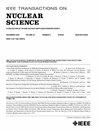Displacement Damage in an Irradiated 4H-SiC MESFET
IF 1.9
3区 工程技术
Q3 ENGINEERING, ELECTRICAL & ELECTRONIC
引用次数: 0
Abstract
Radiation-induced degradation of a commercial 4H-SiC metal-semiconductor field-effect transistor (MESFET) is examined following exposure to 941-MeV Bi ions, 20-MeV protons and 60Co辐照4H-SiC MESFET的位移损伤
研究了商用4H-SiC金属半导体场效应晶体管(MESFET)在暴露于941 mev Bi离子、20 mev质子和60Co γ射线后的辐射诱导降解。退化的主要原因是位移损伤。该装置的辐射强度相当于1兆电子伏的中子通量为2.6\ × 10^{14}$ cm−2。载波去除和迁移率退化对设备退化的相对贡献是可比的。当非电离剂量(NID)为3.1\ × 10^{12}$ MeV/g时,通道迁移率降低了40%。以1 mev中子通量归一化的载流子去除率为$32~\pm ~ $3 $ cm−1,是同类6H-SiC器件的6倍以上。两种多型的载流子去除率的差异显然与辐射缺陷特性的差异有关。退化尺度与弹性非电离能量损失(NIEL)有关,这表明核非弹性相互作用倾向于产生相对于器件通道深度的较长反冲,但对参数退化没有贡献。这意味着对某些类型的器件进行高能质子指向器件表面的鉴定测试可能会导致对器件在空间中的寿命的高估。
本文章由计算机程序翻译,如有差异,请以英文原文为准。
求助全文
约1分钟内获得全文
求助全文
来源期刊

IEEE Transactions on Nuclear Science
工程技术-工程:电子与电气
CiteScore
3.70
自引率
27.80%
发文量
314
审稿时长
6.2 months
期刊介绍:
The IEEE Transactions on Nuclear Science is a publication of the IEEE Nuclear and Plasma Sciences Society. It is viewed as the primary source of technical information in many of the areas it covers. As judged by JCR impact factor, TNS consistently ranks in the top five journals in the category of Nuclear Science & Technology. It has one of the higher immediacy indices, indicating that the information it publishes is viewed as timely, and has a relatively long citation half-life, indicating that the published information also is viewed as valuable for a number of years.
The IEEE Transactions on Nuclear Science is published bimonthly. Its scope includes all aspects of the theory and application of nuclear science and engineering. It focuses on instrumentation for the detection and measurement of ionizing radiation; particle accelerators and their controls; nuclear medicine and its application; effects of radiation on materials, components, and systems; reactor instrumentation and controls; and measurement of radiation in space.
 求助内容:
求助内容: 应助结果提醒方式:
应助结果提醒方式:


